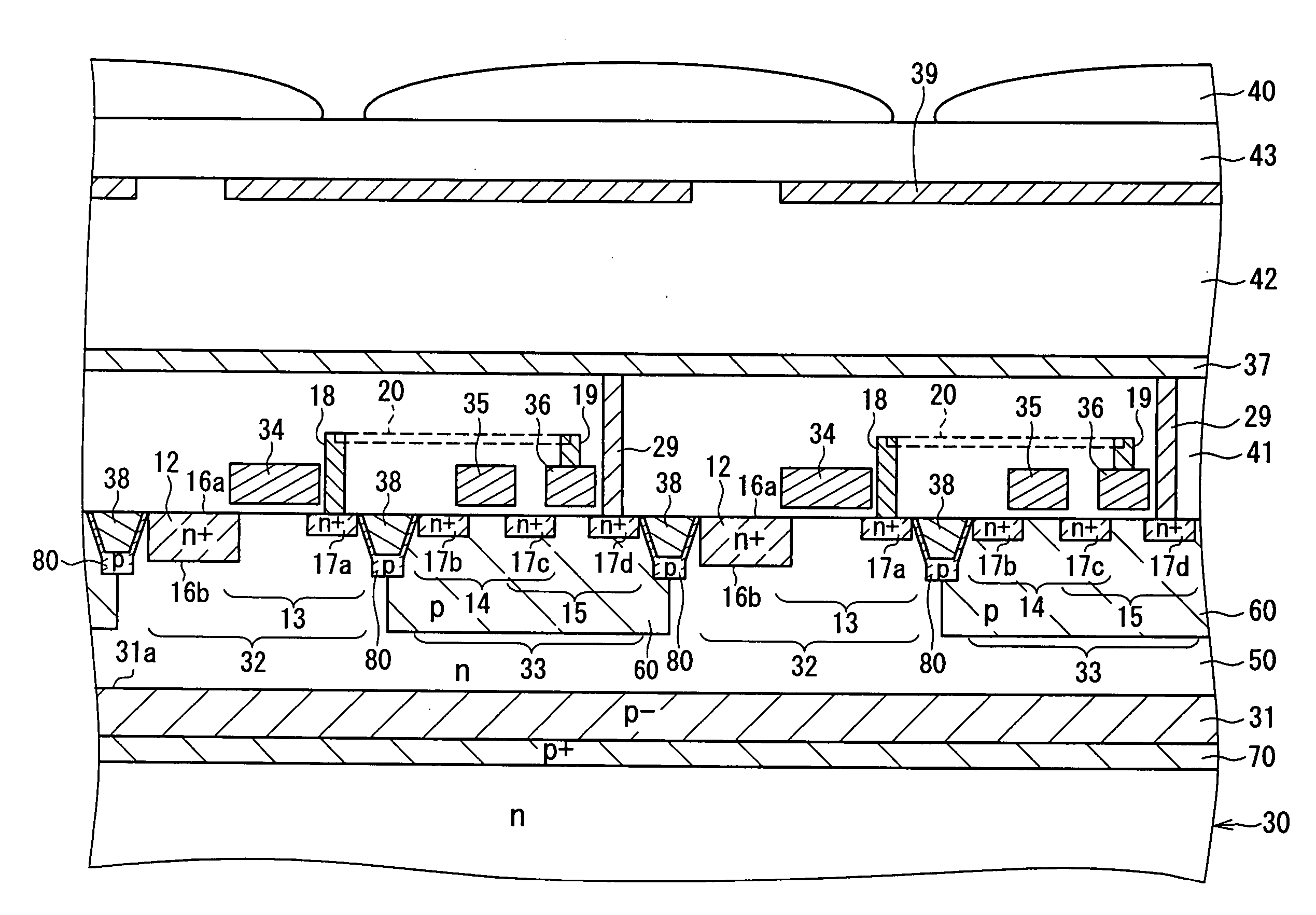Solid-state imaging device
- Summary
- Abstract
- Description
- Claims
- Application Information
AI Technical Summary
Benefits of technology
Problems solved by technology
Method used
Image
Examples
embodiment 1
[0049] The following is a description of a solid-state imaging device according to Embodiment 1 of the present invention, with reference to FIGS. 1 to 3. The solid-state imaging device according to Embodiment 1 is a MOS imaging device and has a circuit configuration similar to the conventional MOS imaging device shown in FIG. 12 except for its cross-sectional structure. This will be described in the following.
[0050] The cross-sectional structure of the solid-state imaging device according to Embodiment 1 will be described referring to FIG. 1. FIG. 1 is a sectional view showing the structure of the solid-state imaging device according to Embodiment 1 of the present invention. As shown in FIG. 1, a p-well 31 is formed in a semiconductor substrate 30 so as to overlap photoelectric conversion portions 32 and signal detection portions 33 when viewed in a thickness direction of the semiconductor substrate 30. In other words, the p-well 31 is formed so that its formation region overlaps a...
embodiment 2
[0073] Now, a solid-state imaging device according to Embodiment 2 of the present invention will be described, with reference to FIGS. 4 and 5. The solid-state imaging device according to Embodiment 2 also is a MOS imaging device and has a circuit configuration similar to the conventional MOS imaging device shown in FIG. 12.
[0074] First, the cross-sectional structure of the solid-state imaging device according to Embodiment 2 will be described referring to FIG. 4. FIG. 4 is a sectional view showing the structure of the solid-state imaging device according to Embodiment 2 of the present invention. In FIG. 4, portions assigned the reference numerals indicated in FIG. 1 are similar to the portions shown in FIG. 1.
[0075] As shown in FIG. 4, in Embodiment 2, second p-wells 60 whose surface side interface coincides with the substrate surface are formed above the p-well 31 in the semiconductor substrate 30. The second p-wells 60 overlap only the signal detection portions 33 when viewed i...
embodiment 3
[0088] Now, a solid-state imaging device according to Embodiment 3 of the present invention will be described, with reference to FIG. 6. The solid-state imaging device according to Embodiment 3 also is a MOS imaging device and has a circuit configuration similar to the conventional MOS imaging device shown in FIG. 12. FIG. 6 is a sectional view showing the structure of the solid-state imaging device according to Embodiment 3 of the present invention. In FIG. 6, portions assigned the reference numerals indicated in FIGS. 1 and 4 are similar to the portions shown in FIGS. 1 and 4.
[0089] As shown in FIG. 6, in Embodiment 3, a p-type buried region 70 having a higher impurity concentration than the p-well 31 is formed below the p-well 31 in the semiconductor substrate 30. The surface side interface of the buried region 70 coincides with the lower side interface of the p-well 31. Further, it is preferable that the impurity concentration of the buried region 70 is set to, for example, 1×1...
PUM
 Login to View More
Login to View More Abstract
Description
Claims
Application Information
 Login to View More
Login to View More - R&D
- Intellectual Property
- Life Sciences
- Materials
- Tech Scout
- Unparalleled Data Quality
- Higher Quality Content
- 60% Fewer Hallucinations
Browse by: Latest US Patents, China's latest patents, Technical Efficacy Thesaurus, Application Domain, Technology Topic, Popular Technical Reports.
© 2025 PatSnap. All rights reserved.Legal|Privacy policy|Modern Slavery Act Transparency Statement|Sitemap|About US| Contact US: help@patsnap.com



